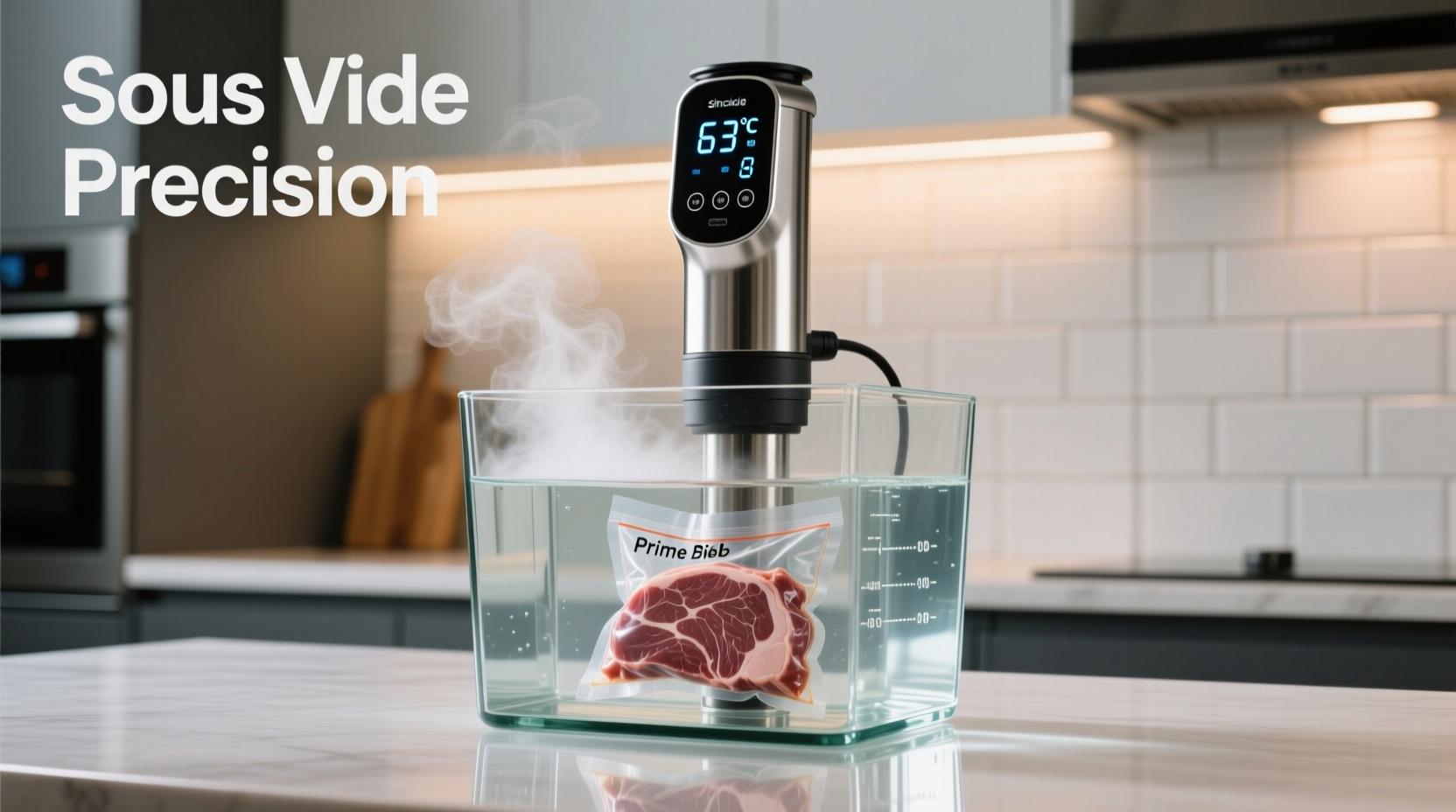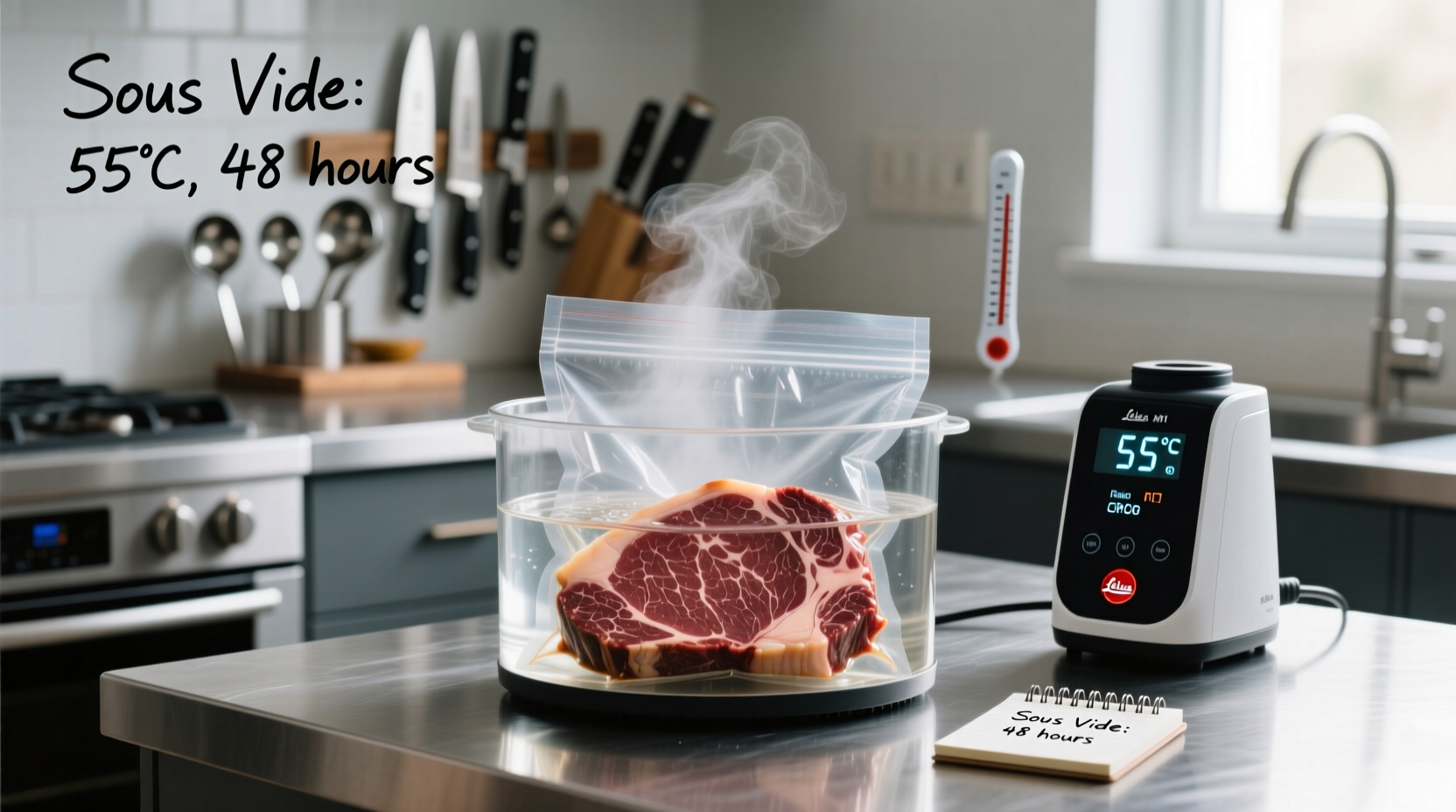Sous vide cooking is a precision method where food is vacuum-sealed in a bag and cooked in a temperature-controlled water bath, ensuring perfect doneness from edge to edge with unparalleled flavor retention and texture control. This technique eliminates guesswork, prevents overcooking, and delivers restaurant-quality results consistently at home.
The Science Behind Perfect Cooking
Unlike traditional methods where heat fluctuates, sous vide maintains water at an exact temperature—typically between 120°F (49°C) and 190°F (88°C)—matching your desired final food temperature. This precise thermal control allows proteins to cook evenly without the gray overcooked bands common in pan-searing or grilling. The vacuum seal locks in natural juices and aromatics, creating an intensified flavor profile impossible with other techniques.
From Military Kitchens to Home Countertops: A Timeline
The sous vide technique traces its origins to 1799 when Sir Benjamin Thompson experimented with vacuum-sealed cooking, but modern precision cooking began in the 1960s when French and American engineers developed industrial food preservation methods. By the 1970s, French chefs like Georges Pralus pioneered its culinary application for foie gras at Troisgros restaurant. The real breakthrough came in 2009 when affordable immersion circulators hit the market, transforming sous vide from a restaurant-exclusive technique to an accessible home cooking method. Today, over 3 million home cooks in the US regularly use sous vide according to a 2024 National Kitchen & Bath Association survey.
Why Chefs and Home Cooks Choose Sous Vide
The precision of sous vide solves fundamental cooking challenges that have frustrated chefs for centuries. When you cook a steak traditionally, the exterior must reach much higher temperatures than the interior to achieve sear, inevitably creating uneven doneness. With sous vide, your 1.5-inch ribeye maintains 130°F (54°C) edge-to-edge, then develops perfect crust via quick sear. This method works equally well for delicate items like salmon or eggs that easily overcook with conventional techniques.
| Cooking Method | Precision | Consistency | Texture Control | Best For |
|---|---|---|---|---|
| Sous Vide | ★★★★★ | ★★★★★ | ★★★★★ | Steaks, chicken breasts, fish, eggs, vegetables |
| Pan-Searing | ★★☆☆☆ | ★★★☆☆ | ★★★☆☆ | Quick-cooking items, developing crust |
| Grilling | ★★★☆☆ | ★★☆☆☆ | ★★★☆☆ | Outdoor cooking, charred flavor profiles |
| Oven Roasting | ★★★☆☆ | ★★★☆☆ | ★★☆☆☆ | Large cuts, hands-off cooking |
Essential Equipment Made Simple
You don't need a professional setup to start. Modern home sous vide requires just three components: an immersion circulator (like Anova or Joule), food-safe vacuum bags or reusable containers, and a container for water (a plastic bin works fine). The circulator heats and circulates water to maintain exact temperatures within ±0.1°F. For sealing, high-end vacuum sealers work well, but the water displacement method (submerging food in a zip-top bag to push out air) delivers excellent results at no extra cost.

What Works Best (and What Doesn't)
Sous vide excels with proteins that typically overcook easily: chicken breasts stay juicy at 150°F (66°C), salmon achieves perfect flakiness at 115°F (46°C), and tough cuts like short ribs transform at 155°F (68°C) for 48 hours. Vegetables like carrots and asparagus develop incredible sweetness when cooked sous vide. However, foods requiring immediate high-heat reactions—like stir-fries or pizza—aren't suitable. Foods that need dehydration (crispy skin, bread crusts) require finishing in a hot pan or oven after sous vide cooking.
Getting Started: Three Foolproof First Recipes
Begin with these beginner-friendly applications that showcase sous vide's advantages:
- Perfect Eggs: Cook at 147°F (64°C) for 45 minutes for custard-like yolks and tender whites
- Restaurant-Style Steak: Set to 130°F (54°C) for medium-rare, cook 1-4 hours depending on thickness, then sear
- Fall-Off-The-Bone Chicken: Cook thighs at 165°F (74°C) for 2 hours for incredibly moist results
Remember that sous vide requires patience—cooking times are often longer than traditional methods—but the consistent results make the wait worthwhile. Always finish meats with a quick sear in a smoking-hot pan to develop flavor through the Maillard reaction, which sous vide alone cannot achieve.
Addressing Common Concerns
Food safety concerns about low-temperature cooking are addressed by precise time-temperature charts developed by the USDA and National Center for Home Food Preservation. When following recommended guidelines (like cooking chicken above 145°F/63°C for at least 30 minutes), sous vide is as safe as any cooking method. The vacuum environment actually prevents bacterial growth better than traditional methods when proper temperatures are maintained.
Practical Tips for Success
Season aggressively before sealing—without evaporation, flavors stay concentrated. Add aromatics like garlic or herbs directly to the bag for infusion. For large batches, don't overcrowd the water bath; maintain at least 1 inch of space between bags. Always dry meat thoroughly before searing for optimal crust development. And most importantly, don't skip the final sear—it's essential for developing complex flavors that sous vide alone cannot create.
Is sous vide cooking worth the investment for home cooks?
Yes, for those seeking consistent results with proteins and delicate foods. An entry-level immersion circulator costs $99-$199 and pays for itself through reduced food waste from overcooking. The technique's precision makes it particularly valuable for cooking expensive cuts like steak or salmon where perfection matters.
Can you cook vegetables sous vide?
Absolutely. Vegetables like carrots, asparagus, and potatoes develop exceptional sweetness and texture when cooked sous vide. Try carrots at 183°F (84°C) for 1 hour with butter and thyme for restaurant-quality results that maintain perfect texture without water-logging.
Does sous vide cooking destroy nutrients?
Actually, sous vide preserves more nutrients than boiling or pressure cooking because food cooks in its own juices without leaching into water. The lower temperatures (compared to boiling) help maintain heat-sensitive vitamins like vitamin C and B vitamins better than high-heat methods.
How long can you leave food in a sous vide bath?
Most proteins have a 'temperature holding window' where they remain safe and maintain quality. Chicken stays safe for up to 4 hours past minimum cook time, while steak can hold for 4+ hours. Always follow USDA time-temperature guidelines for food safety, available through the National Center for Home Food Preservation website.
Do you need special bags for sous vide?
While vacuum-sealed bags work best, high-quality zip-top freezer bags (like Ziploc Freezer) are safe for sous vide up to 195°F (90°C). The water displacement method effectively removes air. Avoid thin sandwich bags and never use bags not labeled as food-safe.











 浙公网安备
33010002000092号
浙公网安备
33010002000092号 浙B2-20120091-4
浙B2-20120091-4